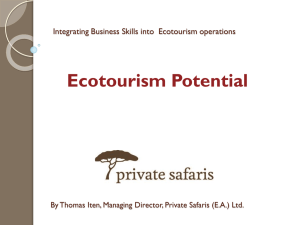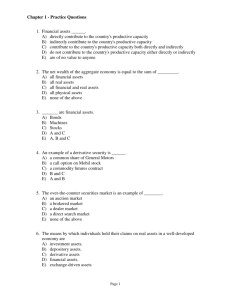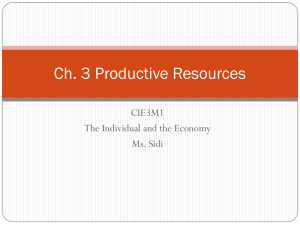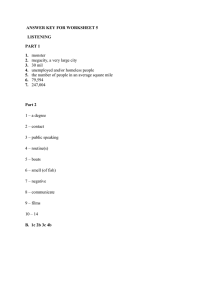Ecotourism: A Tool for Sustainable Development in an Era of...
advertisement
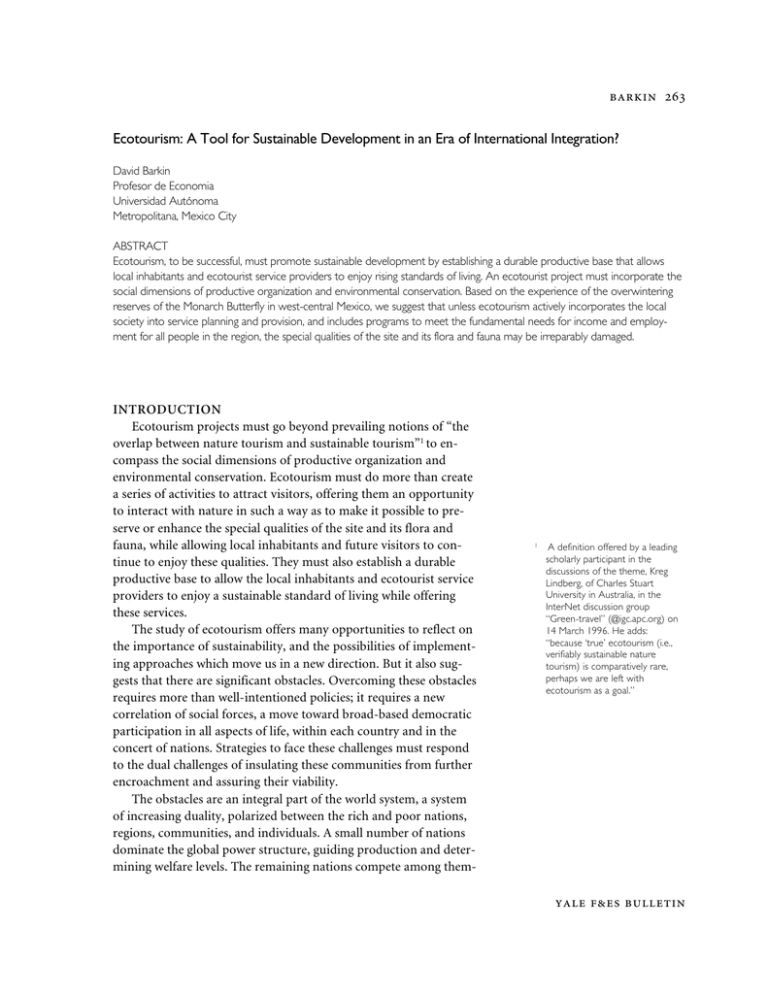
Ecotourism: A Tool for Sustainable Development in an Era of International Integration? David Barkin Profesor de Economia Universidad Autónoma Metropolitana, Mexico City ABSTRACT Ecotourism, to be successful, must promote sustainable development by establishing a durable productive base that allows local inhabitants and ecotourist service providers to enjoy rising standards of living. An ecotourist project must incorporate the social dimensions of productive organization and environmental conservation. Based on the experience of the overwintering reserves of the Monarch Butterfly in west-central Mexico, we suggest that unless ecotourism actively incorporates the local society into service planning and provision, and includes programs to meet the fundamental needs for income and employment for all people in the region, the special qualities of the site and its flora and fauna may be irreparably damaged. INTRODUCTION Ecotourism projects must go beyond prevailing notions of “the overlap between nature tourism and sustainable tourism”1 to encompass the social dimensions of productive organization and environmental conservation. Ecotourism must do more than create a series of activities to attract visitors, offering them an opportunity to interact with nature in such a way as to make it possible to preserve or enhance the special qualities of the site and its flora and fauna, while allowing local inhabitants and future visitors to continue to enjoy these qualities. They must also establish a durable productive base to allow the local inhabitants and ecotourist service providers to enjoy a sustainable standard of living while offering these services. The study of ecotourism offers many opportunities to reflect on the importance of sustainability, and the possibilities of implementing approaches which move us in a new direction. But it also suggests that there are significant obstacles. Overcoming these obstacles requires more than well-intentioned policies; it requires a new correlation of social forces, a move toward broad-based democratic participation in all aspects of life, within each country and in the concert of nations. Strategies to face these challenges must respond to the dual challenges of insulating these communities from further encroachment and assuring their viability. The obstacles are an integral part of the world system, a system of increasing duality, polarized between the rich and poor nations, regions, communities, and individuals. A small number of nations dominate the global power structure, guiding production and determining welfare levels. The remaining nations compete among them- 1 A definition offered by a leading scholarly participant in the discussions of the theme, Kreg Lindberg, of Charles Stuart University in Australia, in the InterNet discussion group “Green-travel” (@igc.apc.org) on 14 March 1996. He adds: “because ‘true’ ecotourism (i.e., verifiably sustainable nature tourism) is comparatively rare, perhaps we are left with ecotourism as a goal.” : selves to offer lucrative conditions that will entice the corporate and financial powers to locate within their boundaries. Similarly, regions and communities within nations engage in self-destructive forms of bargaining compromising the welfare of their workers and the building of their own infrastructure-- in an attempt to outbid each other for the fruits of global growth. The regions unable to attract investment suffer the ignoble fate of losers in a permanent economic olympics, condemned to oblivion on the world stage, their populations doomed to marginality and permanent poverty. Sustainability is not possible as long as the expansion of capital enlarges the ranks of the poor and impedes their access to the resources needed for mere survival. Capitalism no longer needs growing armies of unemployed to ensure low wages, nor need it control vast areas to secure regular access to the raw materials and primary products for its productive machine. These inputs are now assured by new institutional arrangements that modify social and productive structures to fit the needs of capital. At present, however, great excesses are generated, excesses that impoverish people and ravage their regions. Profound changes are required to facilitate a strategy of sustainable development. We explore such an approach, suggesting that ecotourist development strategies may contribute to promoting a new form of dualism: a dual structure that allows people to rebuild their rural society, produce goods and services in a sustainable fashion while expanding the environmental stewardship services they have always provided. Research shows that when given the chance and access to resources, the poor are more likely than other groups to engage in direct actions to protect and improve the environment. From this perspective, an alternative development model requires new ways to encourage the direct participation of peasant and indigenous communities in a program of job creation in rural areas to increase incomes and improve living standards. By proposing policies that encourage and safeguard rural producers in their efforts to become once again a vibrant and viable social and productive force, this essay proposes to contribute to an awareness of the deliberate steps needed to promote sustainability. Ecotourism is widely believed to be the perfect economic activity to promote both sustainability and development. In this essay we examine the relationship between these two goals and end up with some reflections on the organization of specific projects. SUSTAINABILITY Sustainable development has become a powerful and controversial theme, creating seemingly impossible goals for policy makers and development practitioners. Prevailing trickle-down approaches to economic development enrich a few and stimulate growth in “modern” economies and sectors within traditional societies, but they do not address most people’s needs; moreover, they contribute to depleting the world’s store of natural wealth and to a deterioration in the quality of our natural environment. A new discourse of sustainability is emerging, one that troubles thoughtful people, who are realizing the difficulty of implementing such an approach. When fully understood, people realize that present levels of per capita resource consumption in the richer countries cannot possibly be maintained much less generalized to people living in the rest of the world. In the ultimate analysis, we rediscover that in present conditions, the very accumulation of wealth creates poverty. While the poor often survive in scandalous conditions and are forced to contribute to further degradation, they do so because they know no alternatives. Even in the poorest of countries, social chasms not only prevent resources from being used to ameliorate their situation, but actually compound the damage by forcing people from their communities and denying them the opportunities to devise their own solutions. For this reason, the search for sustainability involves a dual strategy: on the one hand, it must involve an unleashing of the bonds that restrain people from strengthening their own organizations, or creating new ones, to use their relatively meager resources to search for an alternative and autonomous resolution to their problems. On the other hand, a sustainable development strategy must contribute to the forging of a new social pact, cemented in the recognition that the eradication of poverty and the democratic incorporation of the disenfranchised into a more diverse productive structure are essential. Sustainability, then, is about the struggle for diversity in all its dimensions. International campaigns to conserve germplasm, to protect endangered species, and to create reserves of the biosphere are multiplying in reaction to the mounting offensive, while communities and their hard pressed members struggle against powerful external forces to defend their individuality, their rights and ability to survive while trying to provide for their brethren. The concern for biodiversity, in its broadest sense, encompasses not only threatened flora and fauna, but also the survivability of these human communities, as stewards of the natural environment and as producers. Internationalization has stymied this movement towards diversity. The powerful economic groups that shape the world economy The proposal calls for creating structures so that one segment of society that chooses to live in rural areas finds support from the rest of the nation to implement an alternative regional development program. : (transnational corporations and financial institutions, and influential local powers, among others) are striving to break down these individual or regional traits, molding us into more homogenous and tractable social groups. They would position us to support the existing structure of inequality and to engage in productive employment; and, for those lucky enough to enjoy high enough incomes, to become customers. SELF-SUFFICIENCY AND THE RELATIONSHIP BETWEEN PRODUCTION AND CONSUMPTION A crucial issue in developing a strategy of sustainability is that of self-sufficiency. The existing process of integration into the global trading system promotes specialization based on monocropping systems. Although sustainability does not lead to autarchy, it is conducive to a much lower degree of specialization in all areas of production and social organization. Historically, food selfsufficiency emerged as a necessity in many societies because of the precariousness of international trading systems; specific culinary traditions developed on the basis of highly localized knowledge of fruits and vegetables, herbs and spices. Although the introduction of green revolution technologies raised the productive potential of food producers tremendously, we soon found out how hard it was to reach this potential and the high social and environmental costs that such a program might entail. Food self-sufficiency is a controversial objective that cogently raises the question of autonomy. Although development practitioners are unanimous in rejecting calls for extreme specialization, there is general agreement on two contradictory factors in the debate: 1) Local production of basic commodities that can be produced equally well but more efficiently elsewhere is a luxury few societies can afford, if and only if the resources not dedicated to the production of these traded goods can find productive employment elsewhere; and 2) There are probably few exceptions to the observation that greater local production of such commodities contributes to higher nutritional standards and better health indices. In the context of today’s societies, in which inequality is the rule and the forces discriminating against the rural poor legion, a greater degree of autonomy in the provision of the material basis for an adequate standard of living is likely to be an important part of any program of regional sustainability. It will contribute to creating more productive jobs and an interest in better stewardship over natural resources. There are many parts of the world in which such a strategy would be a wasteful luxury. It would divert resources from other The poor are more likely than other groups to engage in direct actions to protect and improve the environment. uses that could better contribute to improving well-being. But even when the importation of basic needs is advisable, people concerned with sustainable development raise questions about modifying local diets so that they are more attuned to the productive possibilities of their regions; in the current scene, the tendency to substitute imported products for traditional foods is having terrible consequences for human welfare in many societies.2 Food self-sufficiency, however, is only part of a broader strategy of productive diversification whose tenets are very much a part of the sustainability movement. Historically, rural denizens never have been ‘just’ farmers, or anything else, for that matter. Rather, rural communities were characterized by the diversity of the productive activities in which they engaged to assure their subsistence. It was only the aberration of transferring models of large-scale commercial agriculture to development thinking in the Third World that misled many into ignoring the multifaceted nature of traditional rural productive systems. Sustainable development strategies directly face this problem, attempting to reintroduce this diversity, as they grapple with problems of appropriate scales of operation and product mix. A STRATEGY OF DEMOCRATIC PARTICIPATION FOR RURAL DIVERSIFICATION AND PRODUCTIVE IMPROVEMENT Sustainable development is an approach to productive reorganization that encompasses the combined experiences of local groups throughout the world. The techniques for implementation vary greatly among regions and ecosystems. A single common denominator pervades this work: the need for effective democratic participation in the design and implementation of projects. Another lesson from recent experience is the importance of creating networks to support and defend this work. Without the mutual reinforcement that the international grouping of NGOs provides, the individual units would not be as effective in obtaining funds for their projects, in obtaining technical assistance for their implementation, and political support against intransigent or incredulous local and national politicians and institutions (Friedmann and Rangan 1993). Sustainable development, however, is not an approach that will be accepted, simply because “its time has come.” In the final analysis, it involves a political struggle for control over the productive apparatus. It requires a redefinition of not only what and how we produce but also of who will be allowed to produce and for what ends. For organizations involved in projects of sustainable development in rural areas, the conflict will center around control of mechanisms of local political and economic power, and the use of resources. The struggle to assure a greater voice in the process for 2 The complexity of the task of ending hunger is widely recognized. But recent literature has stressed the social rather than the technical (or supply-based) origins of famine and hunger; Sen (1981, 1982) is a particularly effective exponent of this point, while others have gone into greater detail about the “social origins” of food strategies and crises (Barkin et al. 1990, Garcia 1981, Barraclough 1991). : peasants, indigenous populations, women, and other underprivileged minorities, will not assure that their decisions will lead to sustainable development. But broad-based democratic participation is the best way create the basis for a more equitable distribution of wealth, one of the first prerequisites for forging a strategy of sustainable development. DUALISTIC DEVELOPMENT: A STRATEGY FOR SUSTAINABILITY Global integration is creating opportunities for some, nightmares for many. In this juxtaposition of winners and losers, a new strategy for rural development is required, a strategy that revalues the contribution of traditional production strategies. In the present world economy, the vast majority of rural producers in the third world cannot compete on world markets. Unless insulated in some way, their traditional products only have ready markets within the narrow confines of poor communities suffering a similar fate. But these marginal rural producers offer an important promise: they can support themselves and make important contributions to the rest of society. Present policies are driving peasants from their traditional activities and communities (Barkin, Batt and DeWalt 1991). Peasants and indigenous communities must receive support to continue living and producing in their own regions. Even by the strictest criteria of neoclassical economics, this approach should not be dismissed as inefficient protectionism, since most of the resources involved in this process would have little or no opportunity cost for society as a whole.3 In effect, we are proposing the formalization of a dual economy. By recognizing the permanence of a sharply stratified society, the country will be in a better position to design policies that recognize and take advantage of these differences to improve the welfare of people in both sectors. A strategy that offers succor to rural communities, a means to make productive diversification possible, will make the management of growth easier in those areas developing links with the international economy. But more importantly, such a strategy will offer an opportunity for the society to actively confront the challenges of environmental management and conservation in a meaningful way, with a group of people uniquely qualified for such activities.4 The dual economy is not new. Unlike the present version that permeates all our societies, confronting rich and poor, the proposal calls for creating structures so that one segment of society that chooses to live in rural areas finds support from the rest of the nation to implement an alternative regional development program. The new variant starts from the inherited base of rural production, 3 Many analysts dismiss peasant producers as working on too small a scale and with too few resources to be efficient. While it is possible and even necessary to promote increased productivity, consistent with a strategy of sustainable production, as defined by agroecologists, the proposal to encourage them to remain as productive members of their communities should be implemented under existing conditions. 4 Much of the literature on popular participation emphasizes the multifaceted contribution that the productive incorporation of marginal groups can make to society. (Friedmann 1992, Friedmann and Rangan 1993, Stiefel and Wolfe 1994) While very little has been done on specific strategies for sustainability in poor rural communities, it is clear that much of the experience recounted by practitioners with grassroots groups (e.g. Glade and Reilly 1993) is consistent with the principles enunciated by theorists and analysts alike. improving productivity by using the techniques of agroecology. It also involves incorporating new activities that build on the cultural and resource base of the community and the region for further development. It requires very specific responses to a general problem and therefore depends heavily on local involvement in design and implementation. While the broad outlines are widely discussed, the specifics require investment programs for direct producers and their partners.5 What is new is the introduction of an explicit strategy to strengthen the social and economic base for a dual structure. By recognizing and encouraging the marginal groups to create an alternative that would offer marginal groups better prospects for their own development, the dual economy proposal might be mistaken to be the simple formalization of the “war on poverty” or “solidarity” approach to the alleviation of the worst effects of marginality. This would be erroneous. Rather than a simple transfer of resources to compensate groups for their poverty, we require an integrated set of productive projects that offer rural communities the opportunity to generate goods and services that will contribute to raising their living standards while also improving the environment in which they live. THE LIMITATIONS OF ECOTOURISM: THE MONARCH BUTTERFLY The Monarch butterfly and its 5,000 mile trek between Canada and Mexico have come to symbolize the bridge that is bringing the three nations of North America closer together, forging a single trading bloc. The phenomenon of the overwintering of the Monarch Butterfly was “discovered” some twenty years ago (1974-1976) when researchers from the University of Florida finally traced the flight path from Canada. Of course, their presence was well known to local residents and to a broader segment of the population in west-central Mexico from time immemorial, but with the publication of the details of the journey in Scientific American and National Geographic magazines, its social and economic significance altered conditions in the region. Once announced to the world, the spectacle of the wintering lepidoptera began to attract hundreds of thousands of visitors who make the pilgrimage to the reserves that were created so that this winged caller might enjoy some degree of protection from the ravages of encroachment by human activities. As a result, many of the people living in the region have come to resent the intruder; its annual visits have brought increasing government regulation of their 5 For the more general discussion, see Adelman 1984 and Barkin 1990, ch. 7. FUNDE (1994) offers a specific program for the reconversion of El Salvador based on the principles discussed in this paper. The proposals of groups like the IAF and RIAD offer specific examples of ongoing grassroots efforts to implement initiatives like those discussed here. The Ecology and Development Center in Mexico is pursuing a program of regional development consistent with the proposed strategy (Chapela and Barkin 1995). : lives, effective appropriation of their lands, intense social conflict, and heightened misery. There are serious social and economic problems in the protected area. Many of these problems are simply local manifestations of the larger crisis of Mexican society, making it difficult for poor rural producers to survive by continuing their traditional activities. In this protected area, people have been particularly affected by specific conservation measures that intensified the adjustment process. The declaration of certain important areas to be part of the nuclear and buffer zones of the reserve led to a prohibition or severe restriction on traditional forestry activities, without offering the communities or their members compensation for the reclassification of their lands or alternative productive opportunities with which they might earn a livelihood elsewhere in the region. The region’s problems and those of the communities did not begin in 1986 and cannot be attributed solely to the butterflies. Local systems of control by economic elites and political bosses were an important part of the local scene long before the visitors acquired their new found fame. Industrial demand for sources of pulp, and local mechanisms to concentrate the wealth and opportunities were already creating pressures on the forests and dividing individual communities as well as pitting one against another. The opportunities created by the unbridled expansion of tourism and the arbitrary distribution of the spoils among a very small group of people compounded the problems. In this environment, a new approach to regional development is required. While there is a general recognition that ecotourism can offer more opportunities to the people, it is also clear that without other, complementary productive activities that create jobs and income, the people in the region will continue their environmentally destructive activities that also threaten the viability of the fir forests in which the Monarch nests. A local network of NGOs and confederations of communities and productive groups has begun to play an important role in creating these opportunities. There appears to be an understanding of the great cost that was incurred as a result of the internecine warfare that the strategies of bureaucratic imposition created. The principal limitation, I think, is the lack of a mechanisms for the various groups to implement realistic productive strategies; they need information about resources and markets, as well as mechanisms to channel available resources more effectively. The organizations require a process of local cooperation, constructed on a firm basis of broad-based effective local participation. This is the route to creating a “dual society” in which ecotourism would contribute to an overall strategy of sustainable development. In effect, we are proposing the formalization of a dual economy. By recognizing the permanence of a sharply stratified society, the country will be in a better position to design policies that recognize and take advantage of these differences to improve the welfare of people in both sectors. REFERENCES Adelman, Irma. 1984. Beyond Export-led Growth. World Development 12(9): 937-949. Altieri, Miguel A. 1987. Agroecology: The Scientific Basis of Alternative Agriculture. Westview. Boulder, CO. Andrae, Gunilla and Bjorn Beckman. 1985. The Wheat Trap. Zed Books. London. Barkin, David. 1990. Distorted Development: Mexico in the World Economy. Westview. Boulder, CO. _____ , R. Batt, and B. DeWalt. 1990. Food Crops vs. Feed Crops: The Global Substitution of Grains in Production. Lynne Rienner. Boulder, CO. Barraclough, Solon. 1991. An End to Hunger? The Social Origins of Food Strategies. Zed Press and United Nations Research Institute in Social Development. London and Atlantic Highlands, NJ. Chapela, Gonzalo and David Barkin. 1995. Monarcas y Campesinos: Estrategia de Desarrollo Sustentable en el Oriente de Michoacàn. Centro de Ecología y Desarrollo. México. Friedmann, John. 1992. Empowerment: The Politics of Alternative Development. Basil Blackwell. New York. _____ and Haripriya Rangan. 1993. In Defense of Livelihood: Comparative Studies on Environmental Action. Kumarian Press. West Hartford, CT. Fundación Nacional para el Desarrollo (FUNDE). 1994. Bases para la Construcción de un Nuevo Proyecto Económico Nacional para El Salvador. San Salvador. Garcia, Rolando. 1981. Nature Pleads Not Guilty. In Drought and Man, Vol.1. Pergamon Press. London. Glade, William and Charles Reilley (eds). 1993. Inquiry at the Grassroots: An Inter-American Foundation reader. Inter-American Foundation. Arlington, VA. : Lewis, W. Arthur. 1954. Economic Development with Unlimited Supplies of Labour, republished in A.N. Agarwala and S.P. Singh. 1963. Economics of Underdevelopment. Oxford. New York. Red Interamericana de Agriculturas y Democracia (RIAD). 1993. Qué es la Agricultura Sustentable? Grupo de Estudios Ambientales y RIAD. México. Sen, Amartya. 1981. Poverty and Famines. Oxford University Press. New York. _____ , 1992. Inequality Reexamined. Harvard University Press. Cambridge, MA. Stiefel, Matthias and Marshall Wolfe. 1994. A Voice for the Excluded: Popular Participation in Development: Utopia or Necessity? Zed Books & UNRISD. London & Atlantic Highlands, NJ. Sunkel, Osvaldo 1993. Development from Within: Toward a Neostructuralist Approach for Latin America. Lynne Rienner. Boulder, CO. DAVID BARKIN David Barkin received his doctorate in economics at Yale University and teaches at the Metropolitan University in Mexico City. He was awarded the National Prize in Political Economy and is a fellow of the Academy for Scientific Research. He is also a member of the National Research Council of Mexico. He is an associate researcher at the Mexican Center for Ecology and Development. His current work involves the analysis of the problems of the impact of international economic integration on the environment and on the economic opportunities in Latin America. He continues to have an interest in the process of uneven development which engenders serious disequilibria throughout society. He is the author of more than one dozen books and hundreds of articles in eight languages. His latest books are: Distorted Development: Mexico in the World Economy (in English, Japanese, and Spanish), and Monarchs and Peasants: A Strategy for Sustainable Development in Eastern Michaocan, available only in Spanish. David Barkin, Professor de Economia, Universidad Autonoma, Metropolitana/Unidad Xochimilco, Apartado 23-181 16000 Xochimilco, D.F., MEXICO, Tel: (525) 724-5100, Fax: (525) 724-5235, barkin@cueyatl.uam.mx

